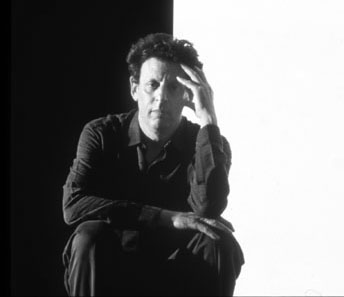

Philip Glass (b. Baltimore, 1937), is commonly known as one of the founders of the “minimalist” school of music. Click here for an in depth biography of the composer. Glass is currently one of the most publicly acclaimed contemporary composers, and he remains incredibly prolific to this day.
Glass’ most significant influences have come from the study of non-Western, and most notably Indian, music under the tutelage of Ravi Shankar, the classical Indian sitar player. Much of his music has experimented with the introduction of non-Western rhythmic patterns into Westernized melodies. Glass’ style has changed since his earliest days as a composer, and most of his current work strays from the strict “minimalist” bounds of his earlier work.
Due to the importance of structure in Glass’ music, most of his compositions are quite symmetrical; although symmetry is probably less important than periodicity in his works, it maintains a strong presence. His music is most concisely described as containing rhythmic complexity overlaid on a gradually evolving pattern. Analyzing Glass’ music is a process of finding the complexity hidden beneath often simplistic patterns, and much of his music deals with the break away from symmetry of form and the subsequent return to symmetry. One example of his music, String Quartet No. 1 (1966), has been a popular subject of analysis due primarily to the striking symmetry of its form. The work consists of eight melodic units which are repeated in their entirety, but then ordered together to form a larger shape. The larger shape is quite symmetrical, and if each section is given a number, the work is designed as follows: 123454321 67876 123454321 67876 12345432. The abrupt ending of the piece without returning to “1” is a typical trick of Glass’, as he breaks the symmetry that the listener has come to expect.
An overview of Glass’ musical style
Scores:
Recordings:
More Sounds:
The following albums are four of Glass’ more accessible collections, and they are excellent places for a
beginning listener to start.
Try Minimalism Out for Yourself:
View the score of Glass' "One +
One" (1967), which
doesn’t require any musical instruments and lets you experiment with minimalism on your own.
Educational Links:
Glass Fragments: Voted
the number one page on the Yahoo list; worth a look, and has great links.
Philip
Glass: A very professional
page that frames its analysis of Glass’ music in the context of other modern composers.
Einstein on the Beach: A page
devoted to Philip Glass and opera, most notably on his opera Einstein on the Beach.
Philip Glass
– Otherminds: Contains
excellent sound bytes.
Recommended Books for Further Research:
Music by Philip Glass. Philip Glass. New York:Harper & Rowe, 1987.
Talking Music: Conversations with John Cage, Philip Glass, Laurie Anderson, & Five Generations of
American Experimental Composers. William Duckworth. New York: Schirmer Books,
1995.
Writings on Glass. Richard Kostelanetz. New York: Schirmer Books, April 1997.
And for comic relief, see:
“Philip Glass buys a loaf of bread,” All in the Timing: Six One-Act Comedies. David Ives. New York:
Dramatists Play Service, 1994.
Most of these books can be ordered over the Internet at Amazon.com.
Page author: Kirsten Lodal